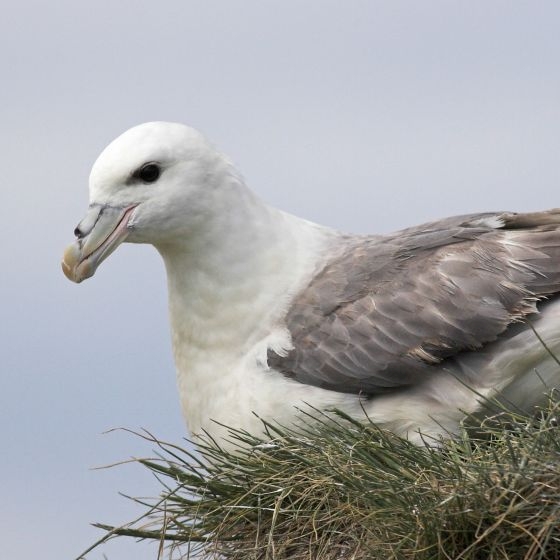Fulmar
Fulmarus glacialis (Linnaeus, 1761)
F.
 FULMA
FULMA  220
220

Family: Procellariiformes > Procellariidae

This robust-looking seabird breeds around the coasts of Scotland, Ireland, Wales, and the south-west and north-east of England, but may be encountered more widely around our shores outside of the breeding season.
Fulmar has a remarkable breeding history, its North Atlantic population originally restricted to St Kilda and an island off the coast of Iceland. The last 250 years have seen a remarkable expansion in Fulmar populations and the colonisation of suitable sites around Iceland, Britain, Ireland, northwest France and sections of the Norwegian coast. The reasons for the expansion are unclear.
Young Fulmars spend their first four or five years at sea, before visiting the colonies at which they will then breed. Even then, they will not breed themselves until they are nine years of age and reach sexual maturity.
Identification
Fulmar identification is often straightforward.
SONGS AND CALLS
Listen to example recordings of the main vocalisations of Fulmar, provided by xeno-canto contributors.
Call
Develop your bird ID skills with our training courses
Our interactive online courses are a great way to develop your bird identification skills, whether you're new to the hobby or a competent birder looking to hone your abilities.
Browse training coursesStatus and Trends
Population size and trends and patterns of distribution based on BTO surveys and atlases with data collected by BTO volunteers.
CONSERVATION STATUS
This species can be found on the following statutory and conservation listings and schedules.
POPULATION CHANGE
The Fulmar is monitored by Seabird Censuses and by the Seabird Monitoring Programme, with sufficient colonies monitored to produce annual trends since 1985; The population increased by 77% between the 1969–70 and 1985–88 Censuses and remained relatively stable until the early 2000s. Numbers have since declined slightly but remain above the level in 1969–70 (JNCC 2022). The Atlas maps show very little change, with a small expansion in range between 1968–72 and 1988–91 being followed by a slight contraction to 2007–11.
DISTRIBUTION
Fulmars breed around almost the entire coastline of Scotland, Wales and Ireland, and in the southwest and northeast of England. They are absent from long stretches of the east and southeast coasts of England, reflecting the limited availability of suitable seacliffs for nesting. In winter, some of these gaps are filled, indicating that Fulmars disperse more widely outside the breeding season.
Occupied 10-km squares in UK
| No. occupied in breeding season | 565 |
| % occupied in breeding season | 19 |
| No. occupied in winter | 563 |
| % occupied in winter | 19 |
European Distribution Map
DISTRIBUTION CHANGE
There have been small changes in breeding distribution.
Change in occupied 10-km squares in the UK
| % change in range in breeding season (1968–72 to 2008–11) | +2.1% |
| % change in range in winter (1981–84 to 2007–11) | +7.2% |
SEASONALITY
Fulmars are present year-round, most often recorded in the breeding season until the abrupt departure of the majority of birds in September, whereafter scarce.

Movement
Information about movement and migration based on online bird portals (e.g. BirdTrack), Ringing schemes and tracking studies.
RINGING RECOVERIES
View a summary of recoveries in the Online Ringing Report.
Foreign locations of birds ringed or recovered in Britain & Ireland

Biology
Lifecycle and body size information about Fulmar, including statistics on nesting, eggs and lifespan based on BTO ringing and nest recording data.
SURVIVAL & LONGEVITY
View number ringed each year in the Online Ringing Report
Maximum Age from Ringing 
|
41 years 11 months 17 days (set in 2019) 
|
Typical Lifespan 
|
44 years with breeding typically at 9 year |
Adult Survival 
|
0.972  
|
BIOMETRICS
Wing Length 
|
Adults | 331.7±13.5 | Range 312–350mm, N=351 |
| Males | 339.5±10.5 | Range 320–357mm, N=72 | |
| Females | 330.1±7.9 | Range 319–342mm, N=37 |
Body Weight 
|
Adults | 772±126.2 | Range 595–970g, N=197 |
Feather measurements and photos on featherbase 
CODES & CLASSIFICATION
Ring size 
|
F |
Field Codes 
|
2-letter: F. | 5-letter code: FULMA | Euring: 220 |
For information in another language (where available) click on a linked name
Research
Interpretation and scientific publications about Fulmar from BTO scientists.
CAUSES AND SOLUTIONS
Causes of change
The reasons behind changes in the Fulmar population are uncertain, but changes in the supply of food by man, e.g. discards from fishing vessels, have been suggested as a possible driver of the increases in the population until the late 1980s (JNCC 2022) and similarly the more recent slight decline may have been influenced by a reduction in the amount of discards (Bicknell et al. 2013). Data from two colonies (one in Scotland and one in Ireland) suggest that there may have been a decline in survival over the period 1974 to 2009 (Cordes et al. 2015); the reasons for this are unclear but this could be a potential consequence from reductions in prey populations and bycatch from fisheries .
Links to more studies from ConservationEvidence.com
Would you like to search for another species?











Share this page